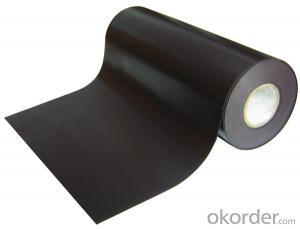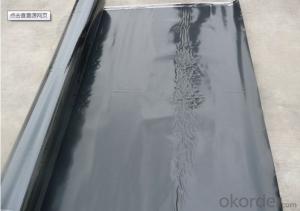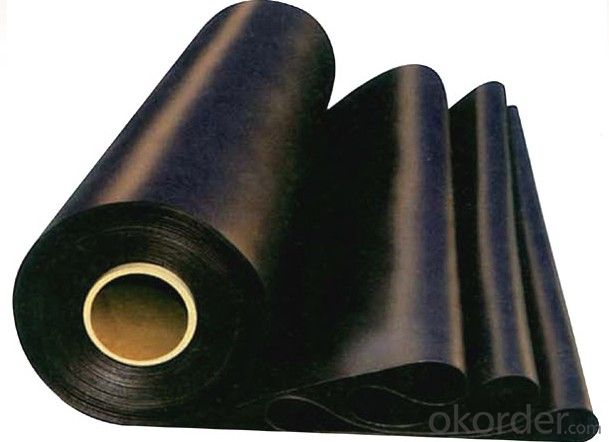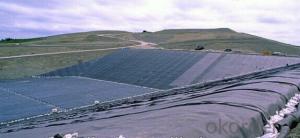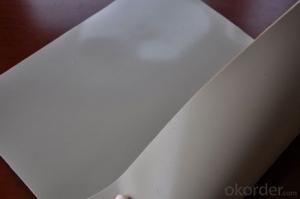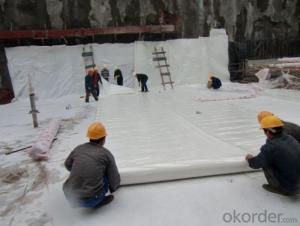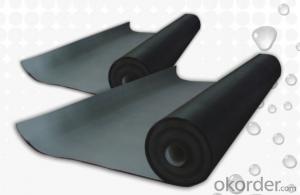EPDM Waterproofing Rubber Membrane Used in Roofing
- Loading Port:
- China main port
- Payment Terms:
- TT OR LC
- Min Order Qty:
- 5000 m²
- Supply Capability:
- 100000 m²/month
OKorder Service Pledge
OKorder Financial Service
You Might Also Like
Products Description:
EPDM waterproofing membrane is the modified materials. They are based upon EPDM rubber with modifier, softener and accelerant assistants added to provide flexibility and stability . Through the precise ingredients, mixing, extrusion, rolling, curing processes to made of modified EPDM Waterproofing material with high strength and high flexibility.
Product Specification:
Tensile Strength N/CM | Normal temperature: 60 ; 60°C: 30 |
Breaking Elongation % | Normal temperature: 400 ; -20°C: 10 |
Tear Resistance N | 20 |
Impermeability, 30 min no leakage | 0.3Mpa |
Low Temperature Bending °C | -20 |
Heating Shrinking mm | Extension: 2 Shrink: 4 |
Heat Resistance (80°C×168h) | Tensile Strength % : 80 ; Keeping rate of adhesive breaking:70 |
Alkali resistance (10% ca (oh)2 solution,normal temperature ×168h)) | Tensile Strength % : 80 ; Keeping rate of adhesive breaking:80 |
Synthetic aging | Tensile Strength % : 80 ; Keeping rate of adhesive breaking:80 |
Characteristic:
1.Excellent anti aging performance ,service life up to 50 years.
2.High extension rate,high tensile strength ,small size changes at heat treatment.
3.Good plant roots penetrability resistance and can be made waterproofing layer of planting roof.
4.Special modified molecular structure ,effectively resolving the current domestic and foreign glue joint problem.
5.Good low temperature flexibility ,and good performance of adapting to ambient temperature changes.
6.Convenient application ,solid joint ,no environment pollution.
7.Chemical corrosion resistance ,can be used for special occasions.
8.Good anti-perforated.
Applicable scope:
1.0mm 1.2mm 1.5mm 1.8mm 2.0mm EPDM waterproof membrane is widely used in roofs, basement, toilet, swimming pool, and all kinds of industry and civil building waterproofing, reservoir, bridge, underground, tunnel and dam waterproofing, especially to the keystone waterproofing projects which is durability, high corrosion resistance and easy deformation.
FAQ of Waterproofing Membrane
a.Can we get some samples before place order?
Answer: We can send the free samples to you by freight collect.
b.How many years can your PVC membrane guarantee?
Answer: We will guarantee the quality for 5 years at least.
c.Which countries you ever export the product?
Answer: We export the PVC membrane to South Africa, Middle east and even European countries.
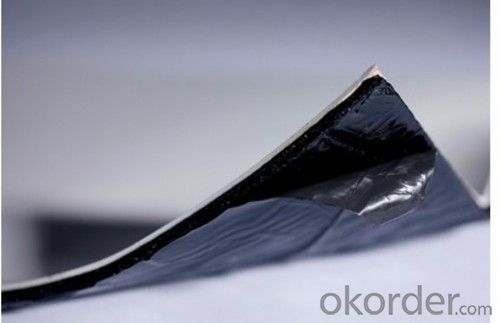
- Q: Can a waterproofing membrane be used on elevator shafts?
- Yes, a waterproofing membrane can be used on elevator shafts. Elevator shafts are vulnerable to water infiltration, and using a waterproofing membrane can help prevent water damage and leakage into the shaft.
- Q: Can waterproofing membranes be used on both horizontal and vertical surfaces?
- Yes, waterproofing membranes can be used on both horizontal and vertical surfaces.
- Q: Can waterproofing membranes be applied on roofs?
- Yes, waterproofing membranes can be applied on roofs. In fact, they are commonly used in the construction industry to provide an extra layer of protection against water infiltration. These membranes are typically made of synthetic materials such as PVC, TPO, or EPDM, which are highly resistant to water and can effectively prevent leaks and water damage on roofs. The application of waterproofing membranes on roofs is a proven method to enhance the longevity and durability of the roofing system, especially in areas prone to heavy rainfall or extreme weather conditions. Additionally, waterproofing membranes are flexible and can be easily installed on various types of roofing materials, including concrete, metal, or asphalt shingles. Therefore, if you want to ensure a watertight roof and protect your property from water-related issues, using waterproofing membranes is a reliable and effective solution.
- Q: Can a waterproofing membrane be used for residential swimming pools?
- Yes, a waterproofing membrane can be used for residential swimming pools. Waterproofing membranes are commonly used in construction to prevent water penetration and can be applied to various surfaces such as concrete, tile, and metal. They create a barrier that prevents water from seeping into the pool structure, which helps to maintain the integrity of the pool and prevent leaks. Additionally, waterproofing membranes can also protect against other forms of damage such as corrosion and deterioration caused by chemicals or harsh weather conditions. It is important to select a high-quality waterproofing membrane that is specifically designed for swimming pool applications to ensure long-lasting protection and durability.
- Q: Can a waterproofing membrane be used on aluminum surfaces?
- Yes, a waterproofing membrane can be used on aluminum surfaces. Waterproofing membranes are versatile and can be applied to various types of surfaces, including aluminum. These membranes are designed to provide a protective barrier against water and moisture, preventing leaks and water damage. Applying a waterproofing membrane on aluminum surfaces can help extend the lifespan of the material by protecting it from corrosion and rust caused by water exposure. However, it is important to ensure that the waterproofing membrane chosen is compatible with aluminum and suitable for the specific application to achieve optimal results.
- Q: SBS modified asphalt waterproofing membrane and synthetic polymer membrane the same, not the same, what is the difference?
- fiber fabric or fiber felt For the carcass, powdery, granular, flake or film material for the cladding material made of curled sheet waterproof material. The use of the construction process is cold construction paving or hot melt paving.
- Q: Can a waterproofing membrane be applied to curved or irregular surfaces?
- Indeed, it is possible to apply a waterproofing membrane to surfaces that are curved or irregular. In the market, there exist flexible waterproofing membranes that have the ability to adapt to different shapes and contours. These membranes have been designed to be stretchable, allowing for manipulation in order to perfectly fit curved or irregular surfaces while still maintaining their excellent waterproofing properties. It is crucial to select a membrane that is explicitly designed for these types of applications and to adhere to correct installation techniques to guarantee a secure and watertight seal.
- Q: Can a waterproofing membrane be used for a plaza deck waterproofing?
- Plaza deck waterproofing necessitates the use of a waterproofing membrane as they are consistently exposed to the elements, such as rain and snow. This is crucial in preventing water infiltration and potential harm to the underlying structure. Waterproofing membranes are specially designed to serve this purpose and safeguard the deck against moisture-related problems like leaks, deterioration, and mold formation. These membranes are typically constructed from materials like bitumen, PVC, or EPDM, and are applied in multiple layers to guarantee a strong and impermeable seal. By utilizing a waterproofing membrane, plaza decks can effectively preserve their structural integrity and longevity.
- Q: Can a waterproofing membrane be used on tunnels with water drainage systems?
- Tunnels with water drainage systems can indeed utilize a waterproofing membrane. The purpose of this membrane is to create a protective barrier against water infiltration and effectively prevent any leakage into the tunnel. However, it is crucial to ensure that the waterproofing membrane is compatible with the specific water drainage system in place. The installation of the membrane must be done in a manner that does not hinder or disrupt the functioning of the drainage system. Moreover, it is important to carefully consider the design and installation of the drainage system to ensure efficient water management and avoid any potential complications that may compromise the effectiveness of the waterproofing membrane. By carefully planning and executing the installation, a waterproofing membrane can effectively uphold the overall integrity and durability of tunnels with water drainage systems.
- Q: Can a waterproofing membrane be used for elevator pits?
- Yes, a waterproofing membrane can be used for elevator pits. Elevator pits are prone to water infiltration, and using a waterproofing membrane can help prevent water seepage and protect the elevator shaft from potential damage.
Send your message to us
EPDM Waterproofing Rubber Membrane Used in Roofing
- Loading Port:
- China main port
- Payment Terms:
- TT OR LC
- Min Order Qty:
- 5000 m²
- Supply Capability:
- 100000 m²/month
OKorder Service Pledge
OKorder Financial Service
Similar products
Hot products
Hot Searches
Related keywords

